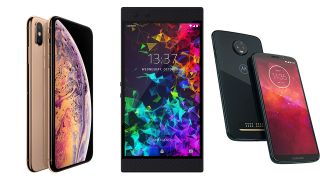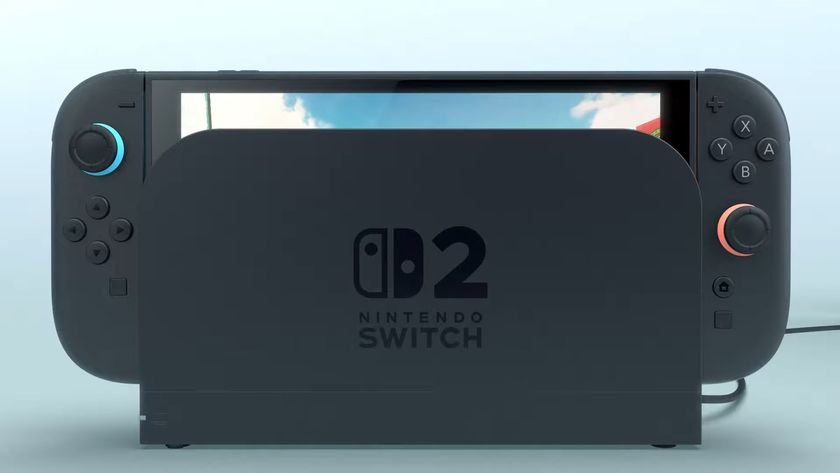How to choose a phone for mobile gaming
We break down the key stats to show you what makes some phones better for mobile play than others

Mobile gaming used to be simple. Games weren't too intensive, and pretty much every phone could run everything. As time goes on, things have gotten more and more complex. Last year’s phone might not run today's games, and manufacturers aren't exactly making things easy. When there are about 100 different models that have been released in the Samsung Galaxy line alone in the last decade, how are you supposed to tell which is the best for mobile gaming?
Fortunately, if you can get into the specs, it becomes much easier to tell which tablets and phones are top performers. Sometimes you have to read between the lines since phone makers like to hide or obscure what a phone's hardware actually is, sometimes. After you read our guide to what makes a great gaming phone or tablet, you'll be equipped to find the best device for you. And, once you’re ready, we have guides to the best gaming phones and best gaming tablets right now, including the lowest prices you’ll pay today.
Gaming on iOS
Before we delve into how to find a good gaming tablet or phone that runs on Android, we'll cover iOS. If you're looking for the best gaming device from Apple, it's a lot easier to figure out which is best at any given time.
If you want to go with iOS, just look at the newest and most expensive device. Unlike Android, iOS is only available on devices that Apple itself releases, so you only have to worry about a handful of product lines. The best iOS gaming phone will be the latest iPhone flagship line. Right now that's the iPhone XS Max, and you can bet that when the next iteration of the iPhone releases later this year, it will be at least a modicum faster, possibly have more RAM, and a better display. For iPads, you'll want to look at the larger of the iPad Pros that are available right now.

One thing to watch with iOS, though, is that Apple's devices tend to get updates and stay relevant much longer than their Android contemporaries. For example, the iPhone 6/6S, which was released in September 2014, is still being updated, although Apple has its own issues with built in obsolescence, whereby older phones slow down and lose battery life far quicker after a couple of years. However, you'd be hard-pressed to find an Android device still receiving updates almost five years after it hit the market, and many of these phones also suffer.
The downside to going the iOS route when gaming is that you're going to pay more upfront for the device and you're more limited in what you can play. On iOS, you'll have to rely on the Apple App Store alone for your games, although you can use the Amazon store too. With Android, you can use the Google Play Store, Amazon Store, and numerous other stores. You can also sideload games, which allows you to play titles independently of any store. If you're going Apple, here are the best iPhone games right now.
Gaming on Android
Picking an Android device to game on is a lot more complicated than iOS. However, you get the advantage of having a lot more freedom when it comes to choosing a phone or tablet, and you'll typically pay less than if you went with Apple.
Sign up to the 12DOVE Newsletter
Weekly digests, tales from the communities you love, and more
Most of the complexity of choosing a device that runs on Android is that the specs between models can be very similar, and manufacturers tend to obscure what type of hardware used in their phones. We'll break down each component below in laymen's terms to let you see through the marketing claims and tell whether a phone or tablet is actually any good or not for gaming. For us, the top Android phones for gaming come from Samsung, Honor, and Razer, and these are the best Android games.

Display - what are the different types?
When you're buying a tablet or phone, there are three things you need to worry about: resolution, pixels per inch, and panel type.
Resolution is an easy one. The higher it is, the better. Sometimes instead of the dimensions of a screen, manufacturers use terms like Quad High Definition (QHD) or Ultra High Definition. Those terms, while being descriptive at their core, are mostly just marketing lingo. Below we break these down for you as they'll be some of the most frequently seen terms when you're looking at a phone or tablet display.
Quad High Definition (QHD) = 2560x1440 pixels = 1440p = 2K
Ultra High Definition (UHD) = 3840x2160 pixels = 2160p = 4K
You're likely already familiar with UHD as it's a marketing term also associated with televisions. However, TVs skipped from 1080p to 4K so QHD might be a new term for you unless you've been shopping for a computer monitor before.
Pixels Per Inch (PPI) is a number that is directly calculated from the size and resolution of a display. There's a fancy equation used to derive this number, but it's mostly marketing. As a rule, a smaller sized display will have a higher PPI than a larger sized display at the same resolution. This is because the smaller the screen, the more pixels have to be packed into an area.

Most of the time, you can just rely on the size of a display and its resolution to visualize how sharp it will be. PPI isn't terribly useful when it comes to choosing a mobile device, and is typically just thrown in because it's a number that marketing can say is more significant than last year's model.
What display type your phone or tablet uses can have a big effect on color reproduction and battery consumption. The two big technologies to worry about in the current market are In-Plane Switching Liquid Crystal Displays (IPS) and Active Matrix Organic Light-Emitting Diode (sometimes just termed Organic Light-Emitting Diode) (AMOLED/OLED).
Out of the two types of displays, AMOLED/OLED is the more desirable. OLEDs allow for per-pixel lighting and don't require a backlight. Because each LED emits its own light, it can also be turned off, so when you see black on an OLED display, it looks a lot less washed out than when viewed on an IPS display.
The primary reason that OLED hasn't replaced IPS is cost. OLED screens are more expensive to produce, as the price to manufacture them goes down they're being used in more and more devices. Most flagship phones and tablets made in the last year use OLED screens, and because each pixel can be individually turned off, you'll see less power consumption with an OLED display as well. Some of the most popular phones that currently feature OLED displays are the iPhone XS, Samsung Galaxy S9 and 10, and OnePlus 6.

CPU - what difference does it make?
With PCs, it used to be easy to tell which Central Processing Unit (CPU) was the best. You'd just pick whichever one pulled the most GHz, and that was that. With the advent of multi-core consumer level processors in the early 2000s, all that changed. Phones and tablets took the same course, albeit a lot faster.

These are our top gaming phones right now, in 2019:
1. Honor View 20
2. Apple iPhone XS
3. Razer Phone 2
The latest mobile chipsets use Octa-core CPUs, and not all those cores translate to raw performance. When looking at a tablet or phone, you'll typically see that the CPU has two different speed ratings. This is usually abbreviated into something that's not precisely comprehensible at first glance. The Google Pixel 3, for example, is often quoted as having a "2.5 GHz + 1.6 GHz 64-Bit Octa-Core" CPU. Well, what does that mean for you if you're just interested in gaming? Well, it can mean that more cores don't necessarily mean more raw processing power.
The latest mobile devices typically only use half of their CPU cores at a time. Half of the cores are geared towards saving power. They run at a lower speed and are meant to be easier on your battery life. When you start doing something intensive, like playing a game, your device will switch to the higher-power set of CPU cores so that you get extra horsepower.
What this means is that more cores don't necessarily make for a better gaming device. A hexacore processor with faster cores may perform better at intensive tasks than an octa-core device, which is designed with power saving in mind more than performance. Additionally, two phones with the same chipset and CPU might benchmark entirely differently when it comes to gaming.
Fortunately, mobile games tend to take into account mid-range devices as well as the latest flagships. As long as you have a phone or tablet using a chipset made within the last year or so you should be able to play any game available for mobile right now. Some phones, like the Honor View 20, even have Gaming+ modes that boost necessary performance for games, while economising on other functions, meaning that while CPUs do work harder the power consumption actually drops. Smart.

RAM - how much do you need?
Random Access Memory (RAM) specs are a lot easier to deal with than CPUs. RAM is basically how much data your device can have active and ready to go at once. For gaming, this means textures, level geometry, character models, and more.
The more RAM you have, the less your phone has to load from flash memory, and the more intensive the graphics can be. Since a mobile device's Graphics Processing Unit shares the same RAM pool as the rest of your phone, the more RAM you have, the better.
Mobile devices still use relatively low amounts of RAM compared to PCs or even consoles. The Pixel 3 we used as an example above comes with 4 GB of LPDDR4X RAM, and you can expect a mid-range tablet or phone to have 2 GB or less. When you've maxed out your RAM in a mobile device, it will automatically start closing processes in the background which will help out if you're concentrated on a game. However, if there's no way to free more RAM, and you max out, you're going to see slowdown and possibly crashes when playing a game. When looking for a device to game on, the more RAM, the better. Aim for at least 3 GB, and try for more. The top end phones have between 6-8GB, and that’s plenty.

GPU - is it important?
Mobile GPUs are almost an afterthought because all of them use a system on a chip. With this sort of design, there's no real discrete GPU like you see in a PC. Instead, the GPU is paired with the CPU. If you get a high-end CPU, you're going to get a high-end GPU. There's no real separating the two with mobile devices. As such, there's no real reason to choose a device based on its GPU.
Conclusion
This guide simplifies the very complex nuances of mobile hardware, but we hope it gives you a better idea about which smartphone or tablet will serve you best. Gaming is often a secondary consideration when a mobile device is being designed so it can be challenging to figure out which the best one is. However, you can check out our guides to find your way. We'll continue to update this guide as time goes on so you can be ready to make the best purchase tomorrow or five years from now.

Ex Nintendo PR managers say the Switch 2 generation is likely to see the retirement of "several of the major developers at Nintendo who we have known for 40 something years"

Helldivers 2 CEO says industry layoffs have seen "very little accountability" from executives who "let go of one third of the company because you made stupid decisions"











